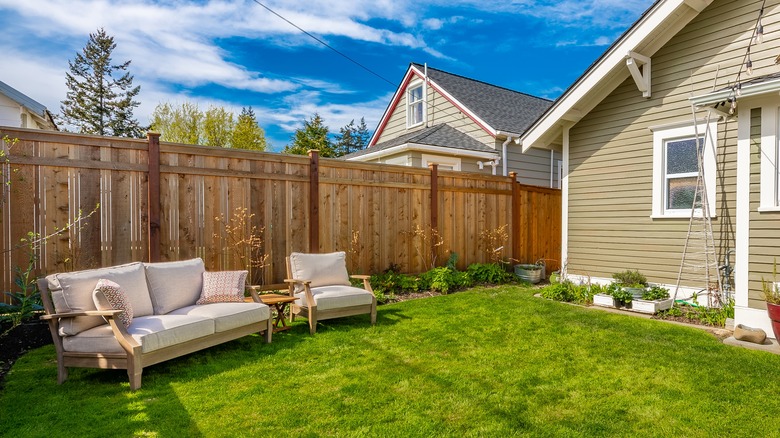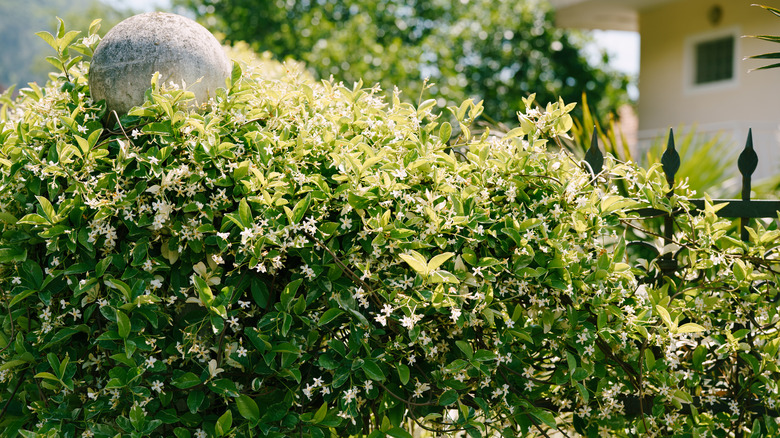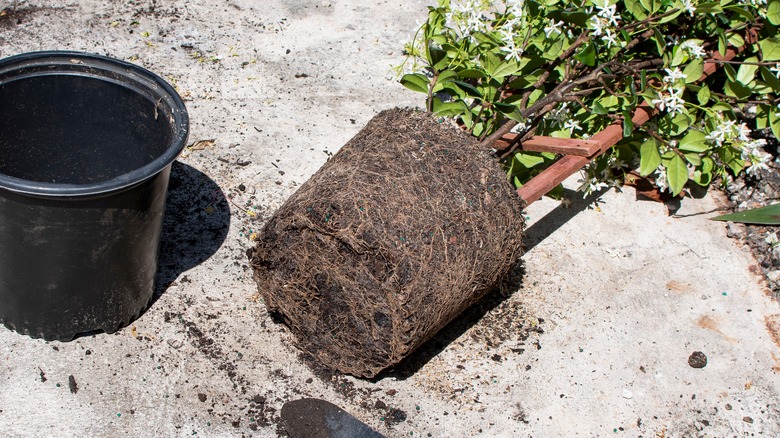This Fresh-Smelling Vine Is Perfect For Added Privacy Along Your Backyard Fence
Few homeowners feel comfortable with neighbors having a full view of their backyard from the kitchen window — even if you get along great. So, what to do if your home is right next to your neighbor's house? Or worse, if you have a fence made of, say, yard-exposing chain link. Simply put, you need a vigorous vine — one that will grow fast and thick with little care. Enter: Star jasmine. From this vine's bountiful shrubbery and pinwheel-like creamy-white bloom clusters with a gardenia-like scent, which notably last from early spring to summer, it's highly possible that this plant is the answer to your privacy problems.
Probably the biggest benefit of star jasmine (aka Trachelospermum jasminoides) is the vine's ability to relatively rapidly scale a fence — once it's established in your garden bed, that is. Branches can grow to lengths of 30 ft., and you can expect full coverage in four to five years. It gets dense and evergreen, so star jasmine is especially useful for adding privacy to chain link, trellis, and other see-through fences.
Do you suffer from a particularly shady garden? This vine loves dappled shade as much as full sun, as long as it's protected from the wind. It also tolerates drought conditions, and is disease and pest hardy, with the exception of occasional infestations of Japanese beetles and scale insects. Unlike us humans, deer are put off by the strongly scented blooms. Bees, on the other hand, are not; star jasmine is a great addition to a pollinator-friendly garden.
Star jasmine might not be the perfect privacy fence vine
Knowing how to successfully grow jasmine plants is one thing; assessing whether star jasmine, specifically, is right for your fence is another. Eating the plant may upset your stomach, and the plant's milky sap can irritate your skin too. Star jasmine, is after all, not a true jasmine (Jasminoides species), but is instead related to oleander, periwinkle, and milkweed. Always wear gloves when pruning. This vine also needs support when young; train or tie shoots to your fence so they grow where you want them. What's more, star jasmine isn't cold hardy. It won't make good fence cover in frosty climates because you need to replant it yearly or bring it indoors during the winter, which is far from convenient.
If you're wondering whether star jasmine is included among invasive vines you should know about, the answer is complicated. Many expert organizations list star jasmine, native to China, Japan, and Korea, as a safe ground cover or an appropriate replacement for problematic climbers like ivy or periwinkle — the California Invasive Plant Council, Plant Right, and the UC Master Gardeners of Inyo & Mono Counties among them.
The Campus Arboretum at The University of Arizona calls star jasmine "benign" with regard to invasiveness while the University of Florida Cooperative Extension Service considers the plant potentially invasive due to its "aggressive, spreading" nature. Garden escapees can weigh down trees they clamber onto or overwhelm native forest edges. It seems, however, that this is only a concern with unpruned and unattended star jasmine vines.
How to buy and grow star jasmine for backyard privacy
Before you buy a bunch of plants, check that you live in USDA Hardiness Zones 7B through 10. That's where star jasmine thrives. Keep in mind, too, that the vine might go by other names locally including Confederate Jasmine, southern jasmine, Chinese star jasmine, or Chinese ivy. Don't get the plant confused with look-alikes (or name-likes) like Jasminum nitidum (angel-wing or star jasmine) or Trachelospermum asiaticum (Asian star jasmine) either. A small vine in a 2.5-quart pot is $23.25 from Home Depot. The Arbor Day Foundation also sells star jasmine in a 1-gallon container for $69.99. On a budget? This plant grows well from cuttings so just ask a neighbor for a stem. You can also grow it from a seed provided you have the patience.
Plant one star jasmine vine every five feet along your fence to ensure full coverage. They prefer to spread out their roots in deep beds with loose, fertile soil and, ideally, to face east or north, particularly in drier climates. To get the most out of your vine covered fence, and by that we mean the most abundant blooms and verdant leaf cover, you need to stick to a strict pruning schedule. As soon as your plant stops producing flowers in the summertime, either snip or pinch the ends off any new shoots to encourage bushy branches over thin vines. Likewise, consider growing star jasmine with clematis: It's one of the best climbing plant pairings for your garden and will assist with your privacy goals too.


